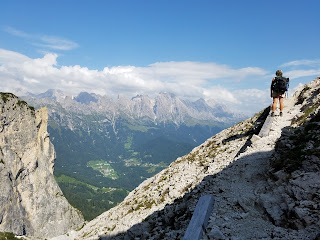(This post will be published in the Jefferson Journal in November 2016.)
Somewhere along the 100 miles of the
Alta Via 2 trail that I hiked, with my friend Mike Kohn, in Italy’s Dolomite
Mountains last September, someone asked us to describe the most beautiful place
we had seen on the trail. I was at a loss to answer, but Mike thought
immediately of a summit along the trail just before a descent to the Lago di
Fedaia at the foot of Marmolada, the highest mountain in the Dolomites. It was
at least an appropriate answer, being one of a number of most beautiful places.
Someone else asked if we could name
the most challenging part of the trail. Certainly just about any of the vie ferrate
– the “iron routes,” with their cables and ladders and iron bars to aid climbs
up (or down) vertical chimneys or along the narrow, crumbling ledge of a trail
– would answer, though the most exhausting hike was a two-mile, 4000-foot
descent.
If someone had asked me what I found
most surprising, I would not have said how beautiful or challenging the hike
was, or how long it was or how welcome the food at the rifugios, but how many
trails crisscross the Dolomites and the numbers of people walking on them.
Trails run around every mountain bend, zigzagging up hills so steep you would
think no one would be crazy enough to take them, yet hikers were everywhere –
strong young people, families with children, robust senior citizens, people who
came out to climb an impossibly steep pass to a small hut for lunch or to take
a trail that included some dangerous via ferrata or that took hours of sweat
and muscle. In many cases the trail was at least one day’s journey from any
rifugio that was at least another day’s journey from a road where the hiker
might have started. The rifugios, especially in the first week, were crowded,
for lunch if not always for the night.
On the second day of our hike, at
the bottom of our first significant pass, Mike and I gaped in disbelief at the
long line of people going up it. The people towards the top were visible only
as a winding whiplash of tiny variously colored dots. On another day, I had to
wait at a bit of via ferrata to let some descending hikers go first. Behind
them came others, then others, then others, until at last I broke into the line
and started up, making the descending hikers wait. On another day, Mike and I
met streams of people going up the side of the mountain we were now going down.
One hiker stopped for a moment to say, in his German accent, “It’s lighter
going down.” He meant “easier,” but I think he was right with “lighter,” too.
So many people doing such strenuous
hiking! I was enormously impressed. I thought about all the hiking Mike and I
had done in the Siskiyous and Cascades to prepare for the Dolomites – Sky Lakes,
Siskiyou, and Marble Mountain wildernesses, numerous Applegate trails, Grizzly
Peak, Soda Mountain, Table Rock, Mt. Elijah to Oregon Caves. Most of the time
we didn’t see another person. In a way, I prefer that, wanting my hiking
experience to be a wilderness experience, but there was something so heartening
about seeing so many people in the gorgeous country of the Dolomites, exerting
themselves so boisterously and enjoying both the exercise and the incomparable
landscape, that I envied the country its hiking culture.
We could have that here. We have the
natural beauty and the trails. We already have a large number of hikers. All it
takes, I think, is a determination to make non-motorized recreation a priority.
Although the trails here are not as crowded as in the Dolomites, I feel the
emergence of a hiking culture here, too. Think about the popularity of the
Pacific Crest Trail, which we are lucky enough to have in our back yard. Five
thousand people started at the Mexican border this summer with the intent of
hiking the PCT to Canada. Think about the crowds of hikers on Table Rock in May
for wildflower viewing. Think about the proposed Jack-Ash and Applegate Ridge
trails between Ashland and Grants Pass.
When I told someone, with great
enthusiasm, that when the Jack-Ash and ART trails are built, we will be able to
walk from Ashland to Grants Pass, she said, “But why would we want to?”
Why did all those people want to
climb those impossible passes in the Dolomites? Why did I walk the entire Alta
Via 2? Why do we have such smiles on our faces as the sweat flies and the legs
ache? Places that have a hiking culture don’t need to ask. We know why.









